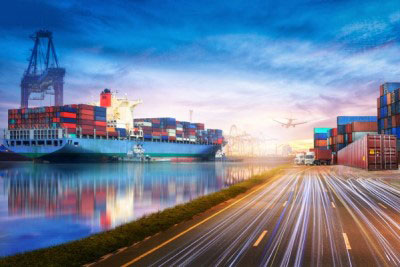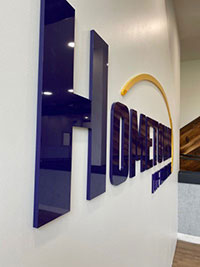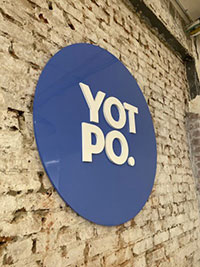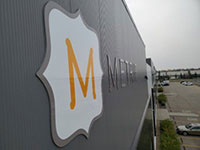Your acrylics sit in Central Asia. Or on a cargo ship in the Pacific. Maybe they’re tucked away in the back of a truck cruising the Plains. Either way, for many businesses, the reality is the product is simply not in stock.
Supply Strain
Backlogged acrylics are common, forcing manufacturers and distributors to stock up and make alternative plans.
By Brian Stanley
(Originally published in the March/April 2022 issue of Insights.)
Your acrylics sit in Central Asia. Or on a cargo ship in the Pacific. Maybe they’re tucked away in the back of a truck cruising the Plains. Either way, for many businesses, the reality is the product is simply not in stock.

Supply chain delays, which have bogged down shipping times and increased prices, are just one of the many unforeseen effects of COVID-19. “We are experiencing delays at all points on the supply chain,” says Gregory Kolenut, National Sales Manager, Marco Awards Group. “It starts in China, with the shortage of equipment—containers, trucks and ships. What used to take a few days to ship now takes two or three months.”
Delays at ports on both coasts only exacerbate the problem. Plus, demand was low during the pandemic’s peak, so the issues weren’t as apparent, Kolenut says. “As COVID subsided, demand grew for all goods and products, causing the crisis.”
Acrylic has been one of the industries most impacted by supply chain issues, says Eric Hausserman, president, Rowmark. “It’s one of the most commonly used plastic resins in the world, and that global demand coupled with reduced output and shipping and logistics challenges has had a negative result on availability,” he says. Around 80% of the company’s products are acrylic; Rowmark’s had challenges at times to get the raw materials needed for manufacturing.
In part, the acrylic woes began with the pandemic’s immediate need to protect people. Companies looking to boost safety were installing transparent plastic barriers in almost every area where employees dealt with the public.
“With the world needing thin gauge acrylic in early 2020 for retail stores and schools, the demand was intense,” says Brad Wald, owner, Acrylic Idea Factory. Before the pandemic, thick acrylic deliveries would take a few weeks. In 2020, that shot up to six to nine months. Wait times have improved but can still be two to three months, Wald says. “By 2022, things have calmed down a little, and acrylic mills are now making limited runs of thicker acrylic. Although there are still some shortages,” Wald says.
In turn, companies weathered the storm in similar ways: stacking up on supplies, proactively reaching out to customers and—like many of us—learning to make do with alternative plans.
Working Ahead
To help mitigate some of the supply chain issues, many companies have stocked up on supplies and sought out alternatives when necessary.




Gemini's Acrylic Signage
Gemini, for instance, has regularly dealt with logistics delays and material shortages. “For our key, high-running raw materials, we made a strategic decision early in the pandemic to order very heavy,” says Courtney Moseman, director of purchasing, Gemini.
With the lead time for imports from Asia increasing significantly in the past 12 months, replenishment planning has been especially challenging, he says. “Our U.S. suppliers have increased their lead times as well,” Moseman says.
Marco’s owner, Marcel Bizier, was also aggressive with purchasing supply before, during and after the pandemic. “While the safer option was to hold off, he wanted to make sure we were well-stocked and ready when we emerged from the lows of the pandemic,” Kolenut says.
Acrylic Idea Factory looked to stock up on items as well. “We buy around five containers of raw acrylic sheets a month to help keep enough in stock at all times,” Wald says.
Acrylic Idea Factory has offered acrylic or acrylic-related products since 1948. That history and decades of relationships with acrylic mills around the world has kept shortages from affecting their business to the point of missing a deadline, he says.
“Over the last two years, the problem was and still is delivery,” Wald says. “With COVID shutdowns, there have been massive delays with shipping containers and domestic delivery. Price increases on raw materials are still evolving, and shipping costs have skyrocketed. As acrylic is 100% of our raw material, we have no alternatives that would match its clarity or versatility. When the awards market slowed down, we offered our customer base new products including gift items, COVID shields, seasonal products and custom products.”
Gemini, meanwhile, has been able to maintain production with normal materials without seeking alternatives. If they identified a category that was too low in inventory or getting close to being out of stock, they looked at an alternative supply base to maintain sufficient inventory, Moseman says.
“The supply issues for Gemini have been minimal because of our inventory strategy to purchase a heavy amount of key raw materials early in the pandemic,” Moseman says. “This strategy has ultimately minimized customer impacts. From time to time, we do run low on some key materials, but throughout the pandemic, we have purchased and stored plenty of raw materials to avoid customer disruptions. This decision has really paid off in the past year-and-a-half as we have had ample material levels to meet customer demand.”
Rowmark’s production and inventory department’s experiences with past supply issues provided some valuable lessons learned to help navigate the company through the pandemic. “We’ve dealt with supply issues in the past, mostly due to weather-related events like hurricanes,” Hausserman says. “While the scale of the supply issues during the pandemic was larger, the way we approached sourcing materials was very similar to a weather-related disruption.”
Over the past 22 years, Rowmark has qualified almost every alternative resin that would be available to them. “We were well prepared to find alternatives when the supply from our primary acrylic source was impacted,” Hausserman says.
And, to be sure, they were affected. “All of the materials that we use to make our engraving sheet have been impacted by supply disruptions, in particular the resins that we use to make our sheet,” Hausserman says. “As a manufacturer, we need multiple contingencies for potential disruptions to the supply of any of our raw materials.”
However, Rowmark’s operational setup put the company in a unique situation, Hausserman says. Rowmark manufactures sheets in the U.S., so they weren’t as impacted by other sheet suppliers who had to both source new or alternate resins and have finished sheets shipped from overseas. “Since we’ve been able to source and qualify multiple vendors, we’ve been able to maintain our 99% global distributor order fill rate, even during the pandemic,” Hausserman says.
Front and Center
Managing customer expectations is critical to navigating supply chain delays, especially to give customers information around potential delays and viable alternative order options.
In addition to maintaining a healthy stock of raw materials throughout the pandemic, Acrylic Idea Factory has also tried to keep customers in the loop when delays could jeopardize an order, Wald says. “If a specific product was not available, we had plenty of alternatives to offer. We’re all in this together, and most customers were willing to work with us to find a solution.”
However, communicating with customers to get ahead of delays can only go so far. “Almost all product lines were affected at some point and to a varying degree,” Kolenut says. “We do our best to divert containers to different ports and order early and heavy, but, at this time, shortages are unfortunately unavoidable.”
For items that were delayed or out of stock, Marco’s customers became very resourceful, Kolenut says. “We typically have a few options to choose from, so the successful retailers were sure to give options to their customers.”
Many companies, including Acrylic Idea Factory, have changed their stock to concentrate on best-selling items, Wald says, with slower-moving items discontinued or being produced on-demand and with longer lead times. “The acrylic industry, like most others, will take a while to settle down and return to normal,” Wald says. “As long as you have the product on the shelf or a customer can wait for us to manufacture the acrylics they need, there will be little effect on our customers.”
That being said, Wald has some advice: “Order early. That’s the key to getting what you need. Dealers should be stocking items—not relying on ‘just-in-time’ for the rest of the year as manufacturers and distributors will still be having stocking issues.”
Looking Ahead
While opinions differ on whether supply chain issues will resolve this year or later on, overall market improvements are expected, with business leaders optimistic about the road ahead—even if there are still lingering challenges to navigate.
“The crush of demand after COVID will help us come up with new solutions and opportunities with international trade,” Kolenut says. Although, as he points out, the rise
in oil prices will likely lead to a rise in acrylic award costs because acrylic is a petroleum-based product.
For Gemini, “I think the only permanent impact is that it forced us to improve fundamental supply chain best practices like materials management, demand planning and supplier performance management,” Moseman says.
After talking with its vendors and industry partners, Rowmark doesn’t feel like there will be any long-term side effects from recent supply issues, Hausserman says. “There may be some lingering issues for other suppliers in getting finished products from overseas, but that’s more of a shipping issue as opposed to any direct effect of the reduced acrylic supply.”
Pardon the Interruption
Supply chain issues have touched just about every sector and company. And while that has had some negative impact, business leaders are making alternative plans. On the plus side, implementing proactive strategies now can help protect against future supply chain shocks, according to McKinsey.
94% Proportion of Fortune 1000 companies that are seeing supply chain disruptions from COVID-19.
75% Proportion of companies that have had supply chain problems negatively affect their business.
55% Proportion of companies that plan to downgrade their growth outlooks (or have already done so).
Strategies companies are implementing to safeguard against future supply chain disruptions:
62% Improving partner/supplier relationships
59% Developing a contingency plan
52% Multi-sourcing and diversifying the supply chain
46% Building up inventory
44% Improving data and analytics
Sources: McKinsey, BarTender by Seagull Scientific, Accenture